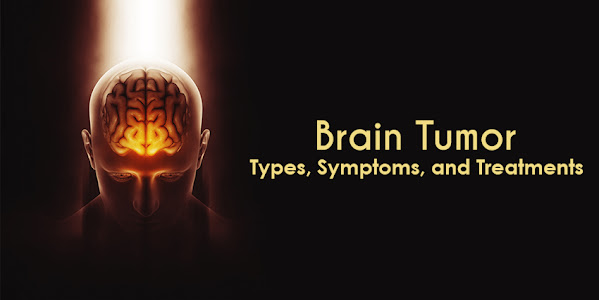BRAIN TUMOR TYPES, SYMPTOMS, AND TREATMENTS
A brain tumor is a collection of unusual, abnormal cells that have grown out of control in your brain. Some brain tumor cells are benign, which means they aren’t cancerous. Others are malignant, which means they are cancerous. The term “Primary Tumor” refers to a brain tumor that starts in the brain. They’re categorized as secondary if they started elsewhere in your body and spread to your brain.
Types of Brain Tumors
Primary brain cancers arise from the brain and central nervous system’s cells. They get their name from the type of cell in which they first appear. There are above 100 different types of brain tumors. The following are the prevalent varieties in adults:
Gliomas: Glial cells, which help maintain nerves healthy, are where these tumors begin. The most common cause is cancer. Gliomas are classified into different groups based on the cells they attack. Adults are the most common victims of astrocytomas. The most dangerous type of glial tumor is glioblastoma.
Meningiomas: The meninges, a thin layer of tissue surrounding the brain and spinal cord, form these. They aren’t cancer, but by pressing on your brain, they can cause difficulties.
Schwannomas. They aren’t cancer, but they can cause hearing loss or balance issues. The protective coating of nerve cells is harmed as a result of this.
Pituitary adenomas: These develop on the pituitary gland, which is located near the base of the brain. It is responsible for the production of essential hormones. These tumors are usually benign and slow-growing.
Benign vs. Malignant Brain Tumors
Benign brain tumors aren’t aggressive and usually don’t spread to surrounding tissues, although they can be severe and even life-threatening. Benign brain tumors usually have well-defined borders and aren’t firmly embedded in the brain. If they’re in a range of the brain where surgery is safe, this makes them easier to remove surgically. They can, however, return. Cancerous tumors are more prone to recur than benign tumors.
Even a benign brain tumor can be dangerous to one’s health. By producing inflammation and increasing pressure on neighboring tissue, as well as inside your skull, brain tumors can harm the cells around them.
Malignant primary brain tumors occur in the brain, grow more swiftly than benign tumors, and invade surrounding tissue quickly. Although brain cancer seldom spreads to other organs, it does have the potential to spread to other areas of the brain and central nervous system.
Brain tumors that have spread to other parts of the brain are cancerous. They result from cancer that began elsewhere in your body and spread (metastasized) to your brain. A secondary brain tumor affects about one out of every four cancer patients.
Brain Tumor Symptoms
The signs of brain tumors vary depending on the nature and location of the tumor. Because different brain parts govern different bodily activities, the tumor’s location influences the symptoms you encounter.
Some tumors are asymptomatic till they reach a specific size, at which point they cause a severe and quick deterioration in health. Other cancers may have slow-developing symptoms.
Common symptoms of brain tumor include:
- Headaches that don’t seem to respond to traditional headache treatments. You might find that you have them more frequently or that they’re more severe than usual.
- History of seizures
- Speech and hearing issues
- Vision challenge
- Balance issues
- Walking problems
- Numbness or tingling arms/ legs
- Memory problem
- Personality changes
- Lack of concentration
- Body weakness (In one part)
- Morning vomit, no nausea
Many illnesses can cause these symptoms. If you experience some of the signs of a brain tumor, don’t assume you have one. Consult your physician. The majority time, doctors are unable to determine the source of a brain tumor. In adults, there are just a few identified risk factors for brain tumors.
Radiation exposure: Children who get head radiation are more likely than adults to acquire a brain tumor.
Family History: Neurofibromatosis and Li-Fraumeni syndrome are two rare hereditary diseases connected to brain malignancies.
Age: The population most likely to be diagnosed with a brain tumor is between 65 and 79.
Chickenpox: According to one study, those who have had chickenpox are less likely to develop gliomas.
Brain Tumor Diagnosis
Your doctor will begin by examining your symptoms, overall health, and family health history to detect a brain tumor. Then they’ll conduct a physical examination, which will include a neurological examination. If a brain tumor is suspected, the doctor may order one or more of the following tests:
- To see detailed images of the brain, imaging techniques such as a CT scan or an MRI are used.
- Angiogram or MRA uses dye and X-rays to check for evidence of a tumor or aberrant blood arteries in the brain.
The doctor may request a biopsy to determine whether the tumor is cancerous. They’ll take a sample of your brain tissue. That’s possible they’ll do it while removing the tumor. They could also pierce your head with a needle through a small hole drilled into it. They’ll submit the sample to a laboratory for analysis.
Brain Tumor Treatment
When selecting how to treat your brain tumor, your doctor will evaluate the following factors:
- The tumor’s location
- The tumor’s size
- Tumor classification
- Whether or not cancer has spread
- Your general well-being
Potential complications
When a brain tumor is discovered, the initial action is usually surgery to remove the tumor. However, due to their position in the brain, some tumors cannot be surgically removed. Chemotherapy and radiation therapy may be used to destroy and shrink the tumor in certain circumstances.
Following surgery, you may receive chemotherapy or radiation to eradicate any leftover cancer cells. Gamma knife therapy, a highly targeted radiation therapy type, may treat cancers deep in the brain or in difficult-to-reach locations.
Because cancer treatment might harm healthy tissue, you should discuss the long-term implications of whatever treatment you are receiving with your doctor. They can explain the dangers of losing specific abilities as well as the possibilities of losing them. The doctor might also discuss the necessity of making plans for post-treatment rehabilitation.
When to see a doctor
If someone has seizures, unexplained eye problems, or speech challenges, consult a doctor. If you have any of the points mentioned below, you should see your doctor:
- Convulsions unexplained vision issues, weakness, numbness, or tingling on one side of the body
- Problems with communicating
- Personality or behavioral changes
To figure out what’s causing the symptoms, a doctor will obtain a complete medical history and run a battery of neurological tests. They might, for example:
- Perform tests to assess balance, vision, and coordination.
- Run CT scans or MRI scans to offer an image of the brain.
In addition, if they uncover a tumor in the brain, doctors may take a tissue sample, or biopsy, to determine its type.
If a person has severe or frequent headaches, they should contact a doctor. They’ll be able to rule out any underlying issues and make recommendations for lifestyle adjustments or treatment.
If you have a brain tumor, your therapy will be determined by the type and stage of the tumor. Surgery, radiation treatment, or chemotherapy may be used to remove or shrink the brain tumor.
Brain Tumor Treatments
Many factors influence brain tumor treatment, including the tumor’s shape, location, size, and the patient’s age and overall health. Adults and children receive treatment in different ways and on different timeframes.
Brain tumors can be treated with surgery, radiation therapy, and chemotherapy. Glioma is a recurrent central nervous system cancer that usually affects the brain, and our experts are working on a vaccine to cure it.
Several approaches may be employed, depending on your requirements. Neurosurgeons, medical oncologists, radiation oncologists, nurses, dieticians, and social workers make up our team, which works together to give the best possible care.
Most patients are given steroids, which are medications that reduce swelling or edema, before starting treatment. Anticonvulsant medication may be used to prevent or control seizures.
If you have hydrocephalus, you may require a shunt to drain the cerebrospinal fluid. A shunt is a long, thin tube inserted into one of the brain’s ventricles and then threaded through the skin to another part of the body, most commonly the belly. It functions similarly to a drainpipe. Excess fluid is absorbed in the belly and transported away from the brain. The fluid is sometimes emptied into the heart.
Surgery
The standard therapy for brain tumors is surgery. A craniotomy is a name for this procedure. A neurosurgeon casts a hole in the skull to remove a brain tumor. The surgeon tries to remove the entire tumor whenever possible. Your doctor might remove as much of the tumor as feasible if it cannot be entirely removed without causing damage to vital brain tissue. Partially removing a tumor relieves symptoms by reducing pressure on the brain and reducing the number of tumors that need to be treated with radiation or chemotherapy.
Some cancers are unremovable. In this scenario, your doctor may simply do a biopsy. A tiny tumor is removed so that a pathologist may look at it under a microscope to see what kind of cells are there. This information aids your doctor in deciding which treatment to utilize.
A biopsy can sometimes be performed with a needle. To detect the specific position of the tumor, doctors utilize a customized head frame (like a halo) and CT scans or MRIs. After creating a hole in the skull, the surgeon inserts a needle into the tumor. Stereotaxis is the term for using this technique to do a biopsy or for treatment.
Brain mapping to detect functional pathways around tumors, endoscopy to do biopsies and open spinal fluid routes using a small scope, and sophisticated frameless stereotaxic computer-assisted tumor resections are other advanced procedures used during surgery. Intraoperative MRI can also be used to help in tumor removal.
Radiation therapy
The use of high-powered rays to kill cancer cells and stop them from developing is known as radiation treatment or radiotherapy. It’s frequently used to destroy tumor tissue that can’t be removed during surgery, as well as to kill cancer cells that may continue after surgery. When surgery is not an option, radiation therapy is utilized.
There are two techniques to deliver radiation treatment. A vast machine emits external radiation. External radiation treatments are typically administered five days a week for a few weeks. The range of treatment is determined by the type and size of the tumor, as well as your age. Giving a total dose of radiation over a long period helps protect healthy tissue in the tumor’s vicinity.
The tumor, the neighboring tissue, or the entire brain may be exposed to external radiation. Radiation is sometimes directed at the spinal cord as well. When the entire brain is treated, the patient frequently receives an additional radiation dose to the tumor site. External radiation or an implant can provide this increase.
Radiation can also come from implant radiation therapy or radioactive material implanted directly in the tumor. Depending on the material utilized, the implant might be left in the brain for a short period or permanently. Every day, a small amount of radioactivity is lost from the implants. During the most active phase of the radiotherapy, the patient is admitted to the hospital for several days.
Another treatment option for brain tumors is the Gamma Knife, often known as stereotactic radiosurgery. The Gamma Knife is a radiation therapy technique that delivers a single, tightly focused, high radiation dosage to its target with pinpoint accuracy. The tumor is bombarded with high-energy rays from a variety of directions. As a result, a high dose of radiation penetrates the tumor while causing minor damage to surrounding brain tissue. One treatment is all that is needed.
Chemotherapy
Chemotherapy is the application of chemicals to cancer cells to kill them. The doctor may employ a single medicine or a combination of treatments, normally orally or injected into a blood vessel or muscle. The medications are injected into the cerebrospinal fluid during intrathecal chemotherapy.
Chemotherapy is typically administered in cycles. Following a treatment time, there is a recovery period, followed by another treatment period, and so on. Most medications may be delivered in the doctor’s office or clinic, so patients don’t need to stay in the hospital for treatment. A brief hospital stay may be required, depending on the medications used, how they are administered, and the patient’s overall condition.
Direct implantation into the tumor cavity using a new approach called convection-enhanced delivery is one of the most recent advances in chemotherapy.
Summary
If somebody has any of the symptoms indicated above, they should see a doctor. Many of the symptoms are similar to those of other conditions and could indicate another health problem.
Keeping track of any symptoms can assist a doctor in making a diagnosis. Keeping track of when and how often symptoms occur can also be beneficial. If a person has symptoms that indicate a brain tumor, it is critical to get a diagnosis and treatment as soon as possible to help prevent the tumor from expanding. Visit University Cancer Centers and consult a professional cancer specialist today.




Comments
Post a Comment